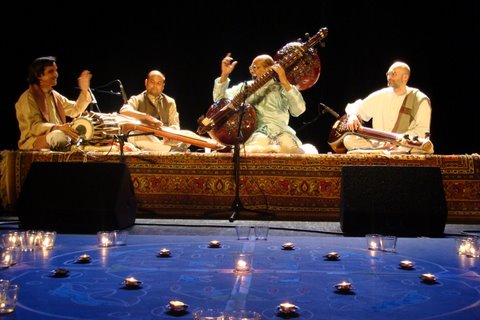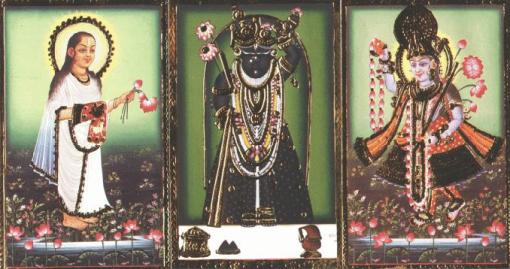
Sri Nathdwara Pakhawaj Parampara
Pakhawaj tradition in Jaipur is centuries old and as described in the ‘Mridang Sagar’ by Pt. Ghanshyam Das Ji, this parampara started in Amer city of Rajasthan by Pt. Tulsidas Ji.
This parampara was developed in Jaipur and since last two centuries has flourished in Sri Nathdwara.
There were several excellent pakhawaj player in Pt. Tulsidas’s family lineage such as Sri Har Bhagat, Sri Chabeel Das, Sri Fakir Das etc. however Pt. Roop Ram Ji from the fifth generation of this family gave this parampara a new signature.
Pt. Roop Ram Ji (birth A.D. 1735) a resident of Amer, came to Jodhpur from Jaipur and served the Jaipur court. He was proficient with hundreds of parans played with Tandav and Raamlila. Around A.D. 1803, Pt. Roop Ram Ji came to Sri Nathdwara along with his young son Sri Vallabhdas Ji and started serving SriNath Ji under the direction of Sri 108 Bade Giridhari Ji Maharaj. Since then his parampara became famous as Nathdwara parampara.
Pt. Roop Ram Ji was a good friend of Pahad Singh Ji (from Bhagwan Das parampara of Akbar court) of Jodhpur darbar. He instructed his son Sri Vallabhdas to learn pakhawaj from Pahad Singh Ji. This is how Sri Vallabhdas Ji completed his pakhawaj learning under Sri Pahad Singh Ji with great efforts.
Sri Vallabhdas Ji had three sons, Sri Chaturbhuj, Sri Shankarlal & Sri Khemalal. Sri Khemalal Ji, based on his experiences and discussions with other musicians, started writing the famous book ‘Mridang Sagar’. Mridang Sagar is a compilation of big taal chakras, matra bheds etc. which were gathered from a lot of old scriptures and also some of his new compositions. Due to untimely demise of Khemalal Ji, the book Mridang Sagar remained incomplete till many years till his nephew and son of Sri Shankar Lal ji, Sri Ghanshyam Das Ji completed it and published it based on his learning from his father.
Sri Purshottam Das Ji was the son of Sri Ghanshyam Das Ji and the eldest member of Nathdwara Parampara. He was an excellent pakhawaj player and was considered amongst the best players of the country. Since he was five years old, he was able to recite and play various taals in traditional ways. Sri Ghanshyam Das Ji used to take little Purshottam along to the temple while playing for the Lord. When he was just nine, his father left for the heavenly abode and he was burdened to carry the parampara. He successfully managed to carry it on his shoulders and served at Sri Nathdwara Temple following his ancestors for many years. Later he joined Bhartiya Kala Kendra and Kathak Kendra at Delhi and finally came back to Sri Nathdwara and left his body there.
He had no son but he trained and developed many good disciples including Sri Prakash Chandra, Sri Shyamlal and Sri Ramkrishna (Nathdwara), Sri Durgalal, Maharaj Chatrapati Singh, Sri Harikrishna Bahera, Pt. Totaram Sharma etc. (The list is long so please forgive me if I’ve missed on any names).
In my next posts, I’ll write more about the pakhawaj playing style of Nathdwara Parampara.









Recent Comments